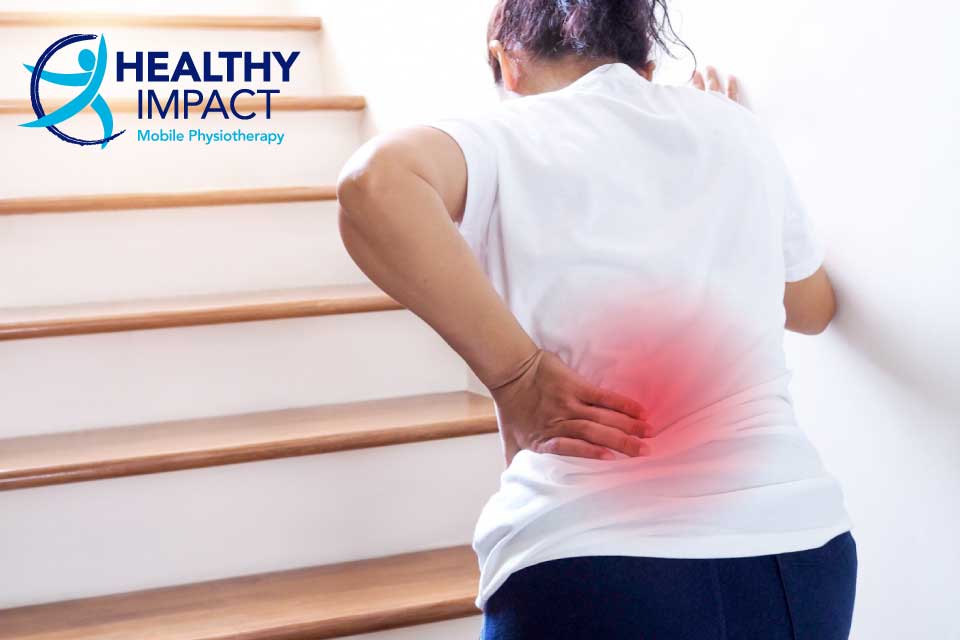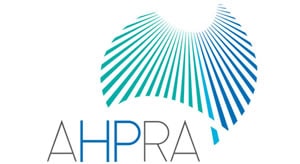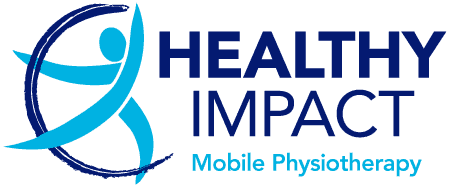What causes sciatica?
Sciatica is the physical injury and/or chemical irritation of the sciatic nerve. Symptoms include lower back pain, buttock pain, with radiating pain, numbness, or weakness down the leg usually beyond the gluteal fold.
Sciatica – The big picture
The back is strong and is supported by many ligaments and muscles. Just like spraining an ankle, it is common for a back or nerve injury to be very uncomfortable and take a few weeks or months to get better.
Your GP will usually first recommend conservative physiotherapy as most people will respond well to physiotherapy treatment. Surgical intervention is only indicated for persistent sciatica not responding to physiotherapy treatment or if there is severe or deteriorating neurological symptoms.
Physiotherapy rehabilitation is often recommended by GPs and specialists prior to considering surgery. Completing conservative treatment whilst waiting for a consult with your specialist can often help speed up the process if surgery is deemed necessary.

Major causes of sciatica
Mechanical. A physical injury or compression of the sciatic nerve. This can be caused by
- A bulging or herniated disc. Degeneration or a disc injury can lead to compression of nerve roots and sciatica.
- Degenerative disc disease. Deterioration of disc height (with age) or disc integrity (crack or tear) leads to compression of nerve roots and sciatica.
- Osteoarthritis of the lower spin Changes in structure of the vertebrae obstructing the nerve pathways and compressing the sciatic nerve.
- Spinal fracture. Displacement of the vertebrae causing compression of the sciatic nerve.
- Spinal stenosis. Narrowing of the central spinal canal exerting pressure on the spinal column triggering symptoms down both legs.
- Foraminal stenosis. Narrowing of the vertebral bony tunnel in which the sciatic nerve exists the central spinal column, triggering symptoms down one leg.
- When one vertebra slips out of place away from the other vertebrae. This can trigger symptoms in one or both legs.
- Acute sciatic nerve injury (the most common cause). When sudden force results in injury to local vertebrae, disc, ligaments, tendon or muscle.
- Piriformis syndrome. In about 70% of the population the sciatic nerve passes through or close to the piriformis muscle in the buttock. This muscle can compress and injure the sciatic neve causing referral pain symptoms down one leg.
Chemical irritation. Caused by inflammation from an acute or chronic injury. An inflamed sciatic nerve can be very uncomfortable. This is usually caused by additional strain being placed on the spine or the adjacent vertebrae, disc, ligament, tendon and muscles resulting in an acute lower back injury.
Inflammation can be caused by;
- Systemic conditions. Like ankylosing spondylitis, psoriatic arthritis, enteropathic arthropathy, juvenile idiopathic arthritis, and reactive arthritis.
- Reduced physical activity. Reduced core and back muscle strength results in reduced capacity to provide stability and to protect your back from injury with normal daily movement activities.
- Repeated acute back injuries or chronic back pain. Inhibits strength and normal muscle function. A history of chronic back or sciatic pain will result in reduced back strength to stabilise and protect your lower back joints and your sciatic nerve from a future acute injury with daily movements and lifting.
- Muscle imbalances. One sided (left or right) muscle weaknesses in your body will increase the shearing force on your spine and adjacent ligaments and muscles, increasing the risk of injuring your lower back and irritating your sciatic nerve.
- Repetitive strain injuries. Repeated loads daily can more frequent injuries. This can lead to reduced core and back muscle strength. This results in the inability to protect and stabilise back joints with your usual daily activities.
- Lifestyle factors. Including excess weight, diet, smoking, and excessive alcohol consumption.

Common symptoms of sciatica?
- Back or hip pain that usually radiates down your leg, usually one leg only, past your gluteal fold. Patients often describe it as burning or electrical shocks down their leg. Radiating pain is often made worse by coughing, sneezing, bending forward or lifting your legs/knees upward and laying on your back.
- Tingling or “pins and needles” known as paraesthesia. This feels like when you sit for too long or sit cross-legged and your leg falls asleep. When you can’t feel sensations on the skin along the nerve pathways around your back or down your leg.
- Muscle weakness in one leg. A more severe symptom. This means the nerve signals to your muscles are having trouble reaching their destinations in your back or legs affecting your ability to walk normally.
- Weakness in both legs, urinary incontinence, bladder retention, faecal incontinence or saddle and/or genital sensory disturbance (inability to feel anything in the body areas that would sit on a saddle). A very severe symptom. It means signals that control your bladder and bowels aren’t reaching their destinations. Please see your GP urgently or attend your local hospital Emergency Department as soon as possible.
Risk factors for sciatica?
- Those aged 20 to 50 are most likely to have herniated a disc. Osteoarthritis of the spine and degenerative disc disease is more common with age. Most of us have some degenerative changes and old spinal injuries, 69% of us will have a bulging disc, osteoarthritis, or disc degeneration by 60 years of age.
- Being overweight increases stress on the spine and the risk to injuring your back.
- Jobs that require repetitive or twisting movements, carrying heavy loads, or exposure to vibration (forklifts, hand tools).
- Prolonged sitting. People who sit a lot are more likely to develop herniated discs than active people are.
- Changes in the way the body uses blood sugar, increases the risk of nerve damage.
How is sciatica assessed?
Accurate assessment is paramount for developing effective treatment plans. A thorough examination includes:
- Patient history. Gathering information about the patient’s medical history, lifestyle, and any previous injuries provides valuable insights.
- Physical examination. Assessing the patient’s range of motion, muscle strength, altered sensation, and neutral reflexes helps identify specific areas of concern.
- Neurological tests. Conducting tests like the straight leg raise and neurodynamic tests can help determine the extent of nerve involvement.
- Diagnostic imaging. Scans are not normally recommended unless your GP determines a clinical reason. They will base their decision on your current presentation, your mechanism of injury, your medical history or if your symptoms are not improving within expected timeframes with physiotherapy. X-ray, MRI, or CT scans are useful to help your medical team rule out any serious conditions like fractures, tumours, cysts or other growths, herniated discs, and spinal or foraminal stenosis.

Physiotherapy treatment strategies for sciatica?
- Activity modification. To manage load on injured area to reduce pain and inflammation.
- Range of movement exercises. To improve blood flow by helping the body heal itself and reduce pain and inflammation.
- Hot and cold therapy. Applying heat or cold packs can help alleviate inflammation and provide relief from sciatic pain. Cold reduces pain and swelling in the early stages and heat improves blood flow.
- Gentle walking in water reduces the effect of gravity and therefore strain on your body whilst circulating blood for healing. If in a lot of pain, cold water will likely increase back pain, so we recommend you start in a heated pool.
- Graded walking. Short and regular walking on a flat surface to start with, can be a good alternative to hydrotherapy if you don’t have access to a pool.
- Finch therapy. Incorporating Finch therapy, a holistic approach to non-invasively restore balance to the musculoskeletal system. It will reduce the load on your injury, help speed up your recovery and help prevent future injuries that may hinder your recovery and rehabilitation.
- Nerve sliders. Help to reduce nerve inflammation and improve nerve healing times.
- Gentle graded strength exercises and stretching. Tailored exercises and stretches help improve flexibility, strengthen muscles, and reduce compression and irritation of the sciatic nerve.
- Posture correction. Poor posture can contribute to sciatic pain. Posture education, graded postural exercises and integration of posture into activities that are meaningful you, can help improve sciatic symptoms and reduce reinjury risk. Ergonomic adjustments in daily activities can prevent further aggravation.
- Manual handling advice. Correct lifting, pushing, pulling, and carrying techniques can help reduce the risk of injury or disease to the musculoskeletal system. It is important to identify and reduce hazardous manual tasks including repetitive movements, repetitive or sustained forces, high or sudden forces, sustained or awkward postures and your exposure to vibration.
- In the early painful stage non-steroidal anti-inflammatory drugs (NSAIDs) or muscle relaxants may be prescribed to help manage pain and inflammation. Medication can help reduce pain so you can do gentle exercises to improve circulation and natural healing.
- Invasive Interventions. In severe cases, when conservative measures fail, interventions like epidural steroid injections or surgery may be considered. However, these options are typically reserved for extreme cases and require careful consideration.
It is very important to continue rehabilitation after your pain has subsided. Pain inhibits normal muscle function by reducing the strength and control of muscle contractions. It only takes a few days to lose muscle mass, strength and function.
If your back and core is still weak and vulnerable, it will be unable to withstand forces from higher demand or advanced activities. The risk of reinjuring your back in the future is much higher and the cycle will continue all over again.
Over 80% of our patients presenting with sciatic symptoms report a positive outcome and reduced dependency on ongoing treatments. Our approach is to ensure that you have the knowledge to help yourself throughout your recovery and into the future to reduce your dependency on regular ongoing treatments. Saving you money.

Conclusion
As a Mobile Physiotherapist dedicated to promoting health and well-being, understanding the causes, assessment methods, and effective treatment strategies for sciatica is essential. Finch therapy, coupled with a multidimensional approach encompassing strength exercises, stretching, and lifestyle modifications, can empower individuals to overcome sciatic pain and regain their quality of life.
Reference list
Adams, A., et al. (2019). Intervertebral Disc Anatomy. StatPearls Publishing.Chou, R., Qaseem, A., Snow, V., Casey, D., Cross, J. T., Shekelle, P., & Owens, D. K. (2007).Diagnosis and treatment of low back pain: a joint clinical practice guideline from the American College of Physicians and the American Pain Society. Annals of internal medicine, 147(7), 478-491.
Genevay, S., Atlas, S. J., & Katz, J. N. (2010). Variation in eligibility criteria from studies of radiculopathy due to a herniated disc and of neurogenic claudication due to lumbar spinal stenosis: a structured literature review. Spine, 35(7), 803-811.
Hopayian, K., et al. (2014). Sciatica: diagnosis and management. BMJ, 348, g3514.
Katz, J. N., et al. (2019). Lumbar Spinal Stenosis. New England Journal of Medicine, 380(8), 756-766.
Nadler, S. F., et al. (2004). The relationship between lower extremity injury, low back pain, and hip muscle strength in male and female collegiate athletes. Clinical Journal of Sport Medicine, 14(2), 74-79.
Shiri, R., et al. (2018). The effect of lumbar extension exercise in the treatment of acute sciatic pain: a randomized controlled trial. Clinical Rehabilitation, 32(6), 768-777.
Wiltse, L. L., et al. (2008). Spondylolisthesis: Classification and Management. Instr Course Lect, 57, 431-445.








